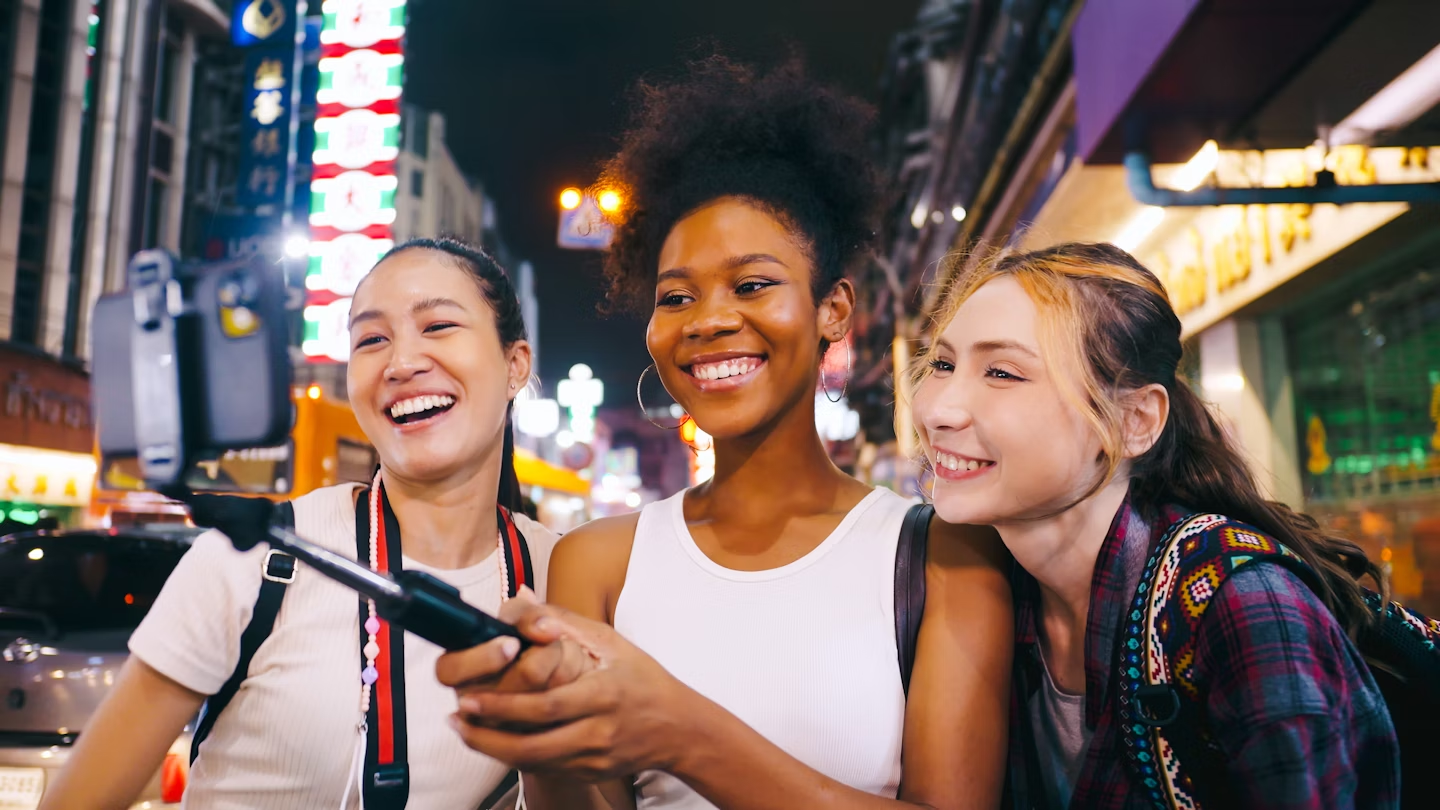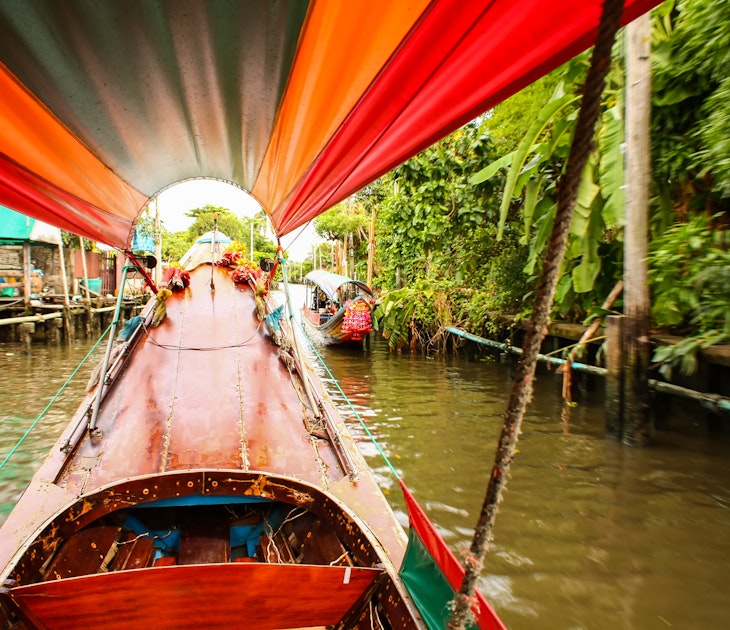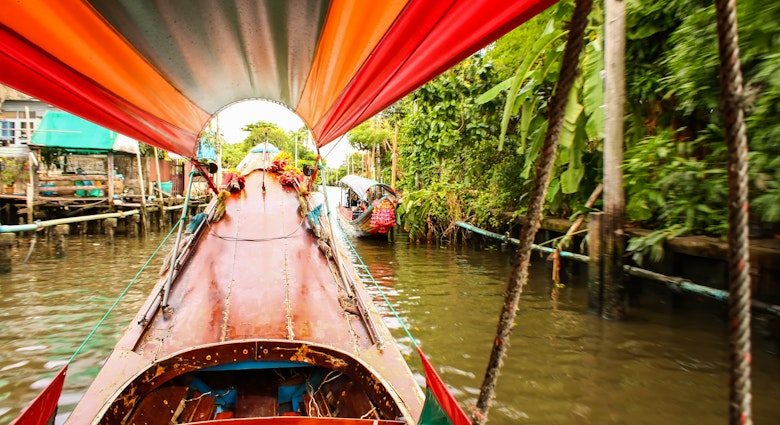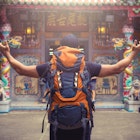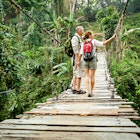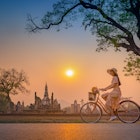As one of the world's favorite budget travel playgrounds, Bangkok has freebies galore. From golden temples, captivating monasteries and vast open-air markets to meditation sessions and people-watching on the most famous backpacker strip in the world, the Thai capital can keep you entertained for weeks, even on the tightest of budgets.
Some of the most famous sights have entry fees, including the legendary Wat Pho and the Grand Palace, but there are countless other religious and historic sites that you can visit for free. With excellent public transport, even getting around won't eat up too many baht – exploring the Chao Phraya River on the public Chao Phraya Express Boat is one of the most pocket-friendly city tours on the planet. Then there's the street food, which will have you eating like a king or queen whatever your budget. Whether you're here for the culture, the architecture or the big-city vibe, here are the best free things to do in the city.
1. Learn some local history at the Bangkokian Museum
Comprising three early-20th-century wooden bungalows, the charming Bangkokian Museum showcases an often-overlooked period of Bangkok's history. Free to visit, the main residential building was constructed in 1937 for the Surawadee family, and its interiors are filled with beautiful wooden furniture, porcelain, and other remnants of pre- and post-war family life.
An adjacent two-story shophouse contains themed displays of similar items. The third building, to the rear, was built in 1929 as a British doctor's clinic. A visit takes the form of an informal guided tour in halting English, and photography is encouraged.

2. Get souvenir-hunting at Chatuchak Weekend Market
One of the largest markets in the world, Chatuchak is a simply unforgettable Bangkok experience, even if you don’t plan on buying anything. It's free to visit, and there are more than 15,000 stalls to explore, divided into 27 covered sections spanning everything from antiques and souvenirs to used vintage trainers, miniature food offerings for spirit houses and live frogs.
Planning tip: The full market operates from 9am to 6pm on Saturday and Sunday. Arrive by 10am to beat the crowds and the heat.
3. Marvel at the nostalgia of Papaya
Technically, many of the objects in this celebrated four-story antique store are for sale, but prices for the owner's collection of 19th- and 20th-century artifacts are so astronomically high that the collection never seems to deplete. Instead, many see Papaya as a museum of recent nostalgia, and it's a great place to browse without any pressure to buy.
Every inch of this warehouse-size exhibition space is stuffed with art deco furniture, 1960s beer signage, superhero statues, Piaggio scooters, typewriters, movie projectors, love seats, TV sets, VHS players, wall clocks, storefront mannequins, lampshades – the list goes on and on.
Planning tip: If you're visiting Papaya, it's worth swinging by nearby Wat Lat Phao on the Lat Phao canal, with its eclectic collection of standing and seated Buddhas.

4. Take in the views from Golden Mount
There are plenty of temples you can visit for free in Bangkok, but the Ayutthaya-era Golden Mount is one of the finest, not least for its stunning views over the surrounding streets. Its glimmering golden chedi (stupa) can be seen shimmering high above old Bangkok and the surrounding canals. The hilltop temple shares a compound with Wat Saket; it's free to visit the monastery, but there's a modest 50B fee to go to the summit.
5. Be mystified by the displays at the Amulet Market
You'll even find fascinating free sights amidst the royal monuments on Ko Ratanakosin island. Close to the river near Wat Pho, the Amulet Market is a bustling hub for the sale of small but highly prized Buddhist talismans and votive objects. Potential buyers (many already sporting chains bedecked with amulets) can be seen bargaining and flipping through magazines dedicated to these objects of devotion, some of which command astronomical prices.
It's a great place to just wander and watch as collectors peer through magnifying glasses at the tiny amulets, seeking hidden meaning and, if they’re lucky, hidden value. The easiest entry point to the market is marked "Trok Maha That."
Planning tip: If you feel like buying an amulet, less valuable talismans can be picked up for as little as 10B and mounted into metal and plastic amulet cases for not much more.
6. Experience sensory overload at Patpong Red Light District
The seedy reputation of the Patpong Red Light District may put off some travelers, but this notorious strip of go-go bars and "exotic" shows is as much a part of Bangkok life as the city's gleaming temples. A visit will reveal much about Thailand's complicated attitudes to intimacy and sexuality, but it's certainly not for everyone.
Though much toned down from its sin city heyday during the Vietnam War, Patpong is still a place of blazing neon, pumping music and scantily-dressed women – its night market even sells erotic toys – but it's now an established stop on the tourist circuit. There's even a museum of Patpong history.
Planning tip: It’s free to wander about the two main strips, but the best time to visit is 5pm when the evening market opens.

7. Be immersed in beauty at Pak Khlong Flower Market
As part of a drive to clean up the city in 2016, Bangkok's famous street-side flower market – Pak Khlong Talat – was moved indoors, but it's still a delightfully fragrant place to visit. Within the giant warehouse that houses the resettled stalls, you'll find piles of delicate orchids, garlands of jasmine flowers, rows of roses and stacks of button carnations.
Planning tip: The best time to come to Pak Khlong Talat is late at night when fresh blossoms arrive from upcountry for sale the following day.
8. Sniff out the fakes at the Museum of Counterfeit Goods
Fakes are so prominent in Bangkok that there’s even a free museum dedicated to them, displaying a mind-boggling array of counterfeit merchandise collected over the years by law firm Tilleke and Gibbins. An in-house lawyer from the company's intellectual property department provides a complimentary tour.
Planning tip: The public can visit on Mondays at 2pm and Thursdays at 10am, but you need to email or call to make an appointment at least 24 hours before your visit.

9. Enjoy the tourism of Khao San Road
From the seedy backpacker ghetto of the 1980s to the atmospheric flashpacker hub of modern times, Khao San Road – technically, Thanon Khao San, from the Thai term kâw sǎhn, meaning "uncooked rice" – has undergone a considerable image makeover over the years. The sleazy, bedbug-infested dives conjured up by Alex Garland in The Beach have been replaced by boutique hotels and hip hangouts, and the downmarket TV bars playing pirated movies have been transformed into sleek designer bars. But still, its legend lives on.
Lined with market stalls and food carts, this pedestrianized thoroughfare remains a lively backpackers’ hub – its energy radiating out along nearby side streets where excellent sleeping, eating and drinking options abound. But the long-simmering debate surrounding its merits continues. Is it too touristy to stay on Khao San Road? Is it "real travel"? Is it really Thailand at all? Our advice is just go. It’s free, it oozes atmosphere, and it poses its own riddle: if a traveler goes to Bangkok but doesn’t visit Khao San Road, did they really visit Bangkok?
Planning tip: Bring an appetite to Khao San Road! Inexpensive street food options abound – as the sun starts to set, carts touting satay skewers, pad thai noodles and popiah (deep-fried spring rolls) spill out onto Thanon Khao San and the surrounding streets.
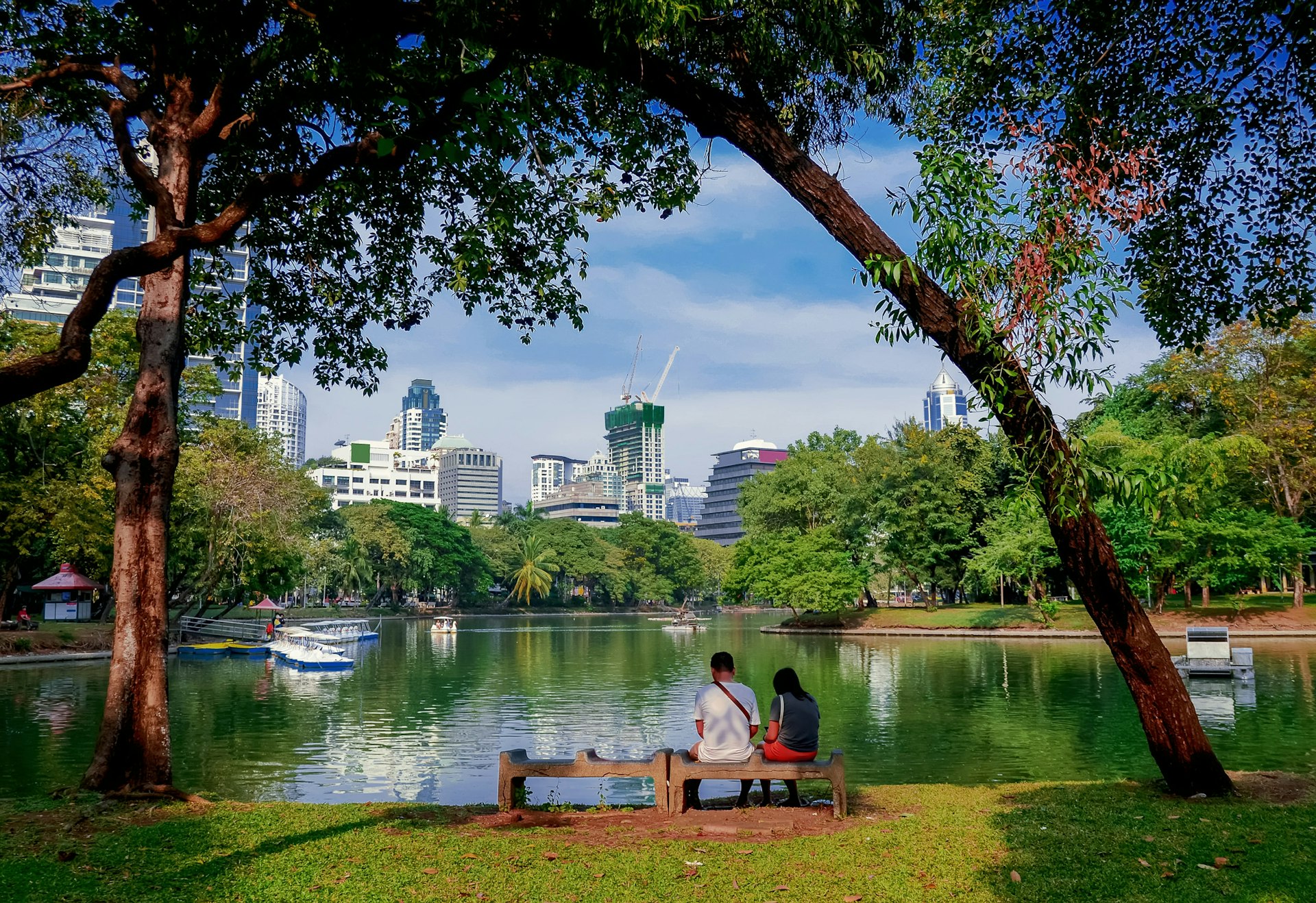
10. Unwind in Lumphini Park
Bangkok isn't known for its calm, green spaces, but Lumphini Park is a breath of fresh air. This sprawling city park is a chlorophyll-infused antidote to Bangkok's traffic fumes-filled streets and sun-blocking skyscrapers. With manicured lawns, thickets of trees, winding walkways and swan-shaped pedalos for hire on its glassy lake, this free-to-visit park is a great spot to pause and recharge. Many locals start their mornings here at first light with a little tai chi.
Planning tip: Combine a visit to Lumphini Park with a wander around nearby Benjakiti Park, once part of the monarchy-owned Tobacco Monopoly. Today, this former industrial zone has wetland boardwalks, woodland zones, and cycle paths with bikes for rent.
11. Pay respect at the King Prajadhipok Museum
This free museum assembles old photos and memorabilia to illustrate the dramatic life of Rama VII (King Prajadhipok), Thailand's last absolute monarch. It occupies a grand neocolonial-style building that was constructed on the orders of Rama V for his favorite firm of Bond Street merchants – the only foreign-owned business allowed on the royal road linking Bangkok’s two palace districts.
Prajadhipok did not expect to become king, but once on the throne, he showed considerable diplomacy in dealing with what was, in effect, a revolution fomented by a new intellectual class of Thais. The first floor deals with the life of Queen Rambhai Barni, while the upper two floors cover the king’s own life. A coup, carried out while the king and queen were playing golf, ended Thailand’s absolute monarchy in 1932.

12. Soak up the creative energy of the Creative District
The Bang Rak district has become a magnet for creative types in recent years. For a taste of the Thai art scene, check out Warehouse 30, a collection of shops, workspaces and cafes offering regular lectures and exhibitions in a refurbished World War II-era building. After you’ve browsed the work of local designers, go and see the mural by street artist Vhils – a collection of faces and eyes carved into the concrete wall outside the Portuguese Embassy.
13. Experience some nature in Wachirabenchathat Park
For a dose of nature in Bangkok, head to Wachirabenchathat Park, which encompasses three of the city’s best parks in one. Known locally as Suan Rot Fai (Railway Park) because the State Railway of Thailand once had a golf course here, it’s now a collection of calm green spaces with neatly trimmed gardens, running tracks, lakes and plenty of trees. Come after a trip to Chatuchak Weekend Market to revive yourself after a day’s hard haggling.
14. Be fascinated by the Bangkok Doll Factory & Museum
This workshop was founded by Thai doll enthusiast Khunying Tongkorn Chandavimol in 1956 after she completed a doll-making course in Japan. Her dolls draw on Thai mythology and various historical periods, and the collection includes some 400 dolls from around the world, plus important pieces from her own workshop, where you can watch the figures being crafted by hand for free.
Planning tip: The museum is tricky to find; take a taxi from BTS Phaya Thai and get the driver to call the museum for directions.

15. Make a pilgrimage to Erawan Shrine
The striking Erawan Shrine was built in 1956 as a last-ditch effort to end a string of unfortunate events that occurred during the construction of the since-demolished Erawan Hotel. It's consecrated to honor the Hindu god Brahma, creator of the universe, and serves a similar function to the spirit houses seen outside most Thai houses in propitiating divine presences. A bomb exploded near the shrine in August 2015, killing 20 and slightly damaging the shrine, but it was quickly repaired and reopened days later.
The story of its construction is fascinating. After incidents ranging from injuries to construction workers to the sinking of a ship carrying marble for the hotel, a Brahman priest was consulted. Since the hotel was to be named after the elephant escort of Indra in Hindu mythology, the priest determined that Erawan required a passenger and suggested it be Lord Brahma. A statue was built, and, lo and behold, the misfortunes miraculously ended. The hotel was demolished in 1987, but the shrine remains – it's free to visit and an important place of pilgrimage for Thais.
16. Try something new at Khlong Toey
Make an early morning trip to the city’s largest wet market to discover where most street vendors and restaurateurs source their richly varied ingredients. Ironically named Khlong Toey after the fragrant pandan leaf, the air here is usually thick with the smell of freshly gutted fish or the pungent odor of durian. The sights are better than the smells, so get here early and bring a camera. By 10am, most vendors have already packed up and left.

17. Get lost in Bangkok's Chinatown
Thick with the scent of traditional herbal medicines, Bangkok's Chinatown offers a sensory experience that you won’t find anywhere else in the city. The narrow market alleys off Yaowarat Road are crammed with bird's-nest soup restaurants, dangling lanterns, gaudy gold and jade shops, and flashing neon signs in Chinese characters. It is Bangkok’s most hectic neighborhood, where half the fun is in getting completely lost.
Planning tip: Come in the afternoon, and you can stay on to graze at the fantastic street food stalls on and around Thanon Yaowarat. Things get going from around 6pm, but the food markets (and many Chinatown restaurants) close on Mondays.
18. Watch artisans at work at Ban Baat
The residents of Ban Baat inhabit the last of the villages established by Rama I (r 1782–1809) to produce bàht, the distinctive bowls used by monks to receive their morning donations of alms. To find the main alleyway that marks the center of the village, head to Thanon Bamrung Meuang, turn down Soi Ban Bat, then take the first right.
Tourists – not temples – are among the main customers these days, and a purchase is usually rewarded with a bàht-making demonstration where eight separate pieces of steel, said to represent Buddhism’s eightfold path, are hammered together to create a single bowl. Expect to pay around 300B for a small bowl – or watch artisans making bowls for others for free.
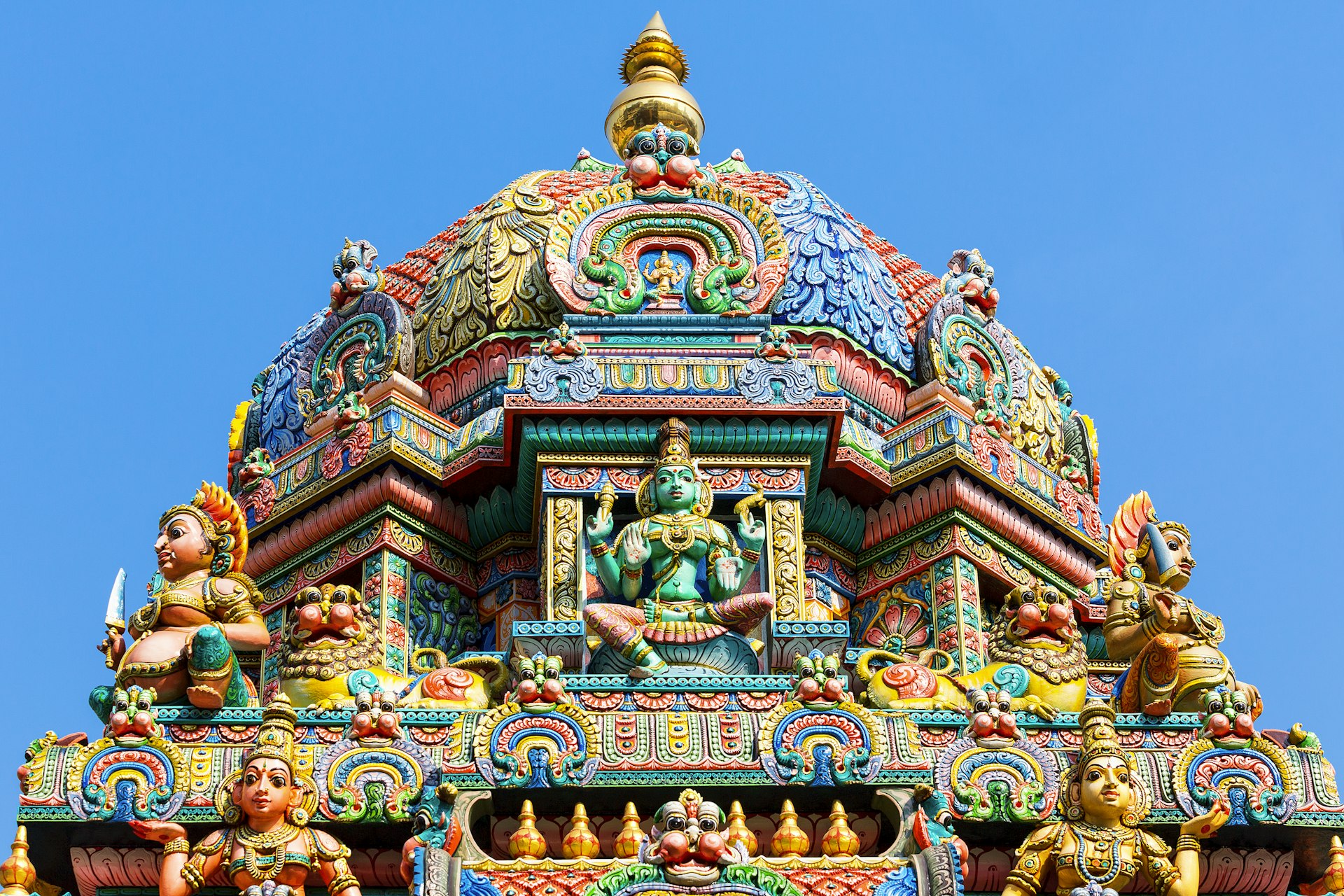
19. Discover Thailand's varied cultures at Sri Mariamman Temple
While Bangkok is primarily Buddhist, the city also has a sizeable population of Hindus, most originally from South India. With its looming, deity-covered gopuram (gateway tower), the arrestingly flamboyant Sri Mariamman temple is a wild collision of colors, shapes and religious imagery, and it’s free to visit, though leaving a donation is appropriate. Created in the 1860s by Tamil immigrants, its statues are a full-color guide to many of the most important Hindu deities.
Planning tip: While visiting the Sri Mariamman temple, it's worth pausing to enjoy some of the excellent South Indian vegetarian food in the area. The popular, canteen-style Saravana Bhavan is a great place to start.
20. Catch a puppet show at the Artist's House
Sort of a gallery, kind of a coffee shop, something of a cultural center… it's tough to categorize this old wooden house on Khlong Bang Luang in Thonburi. There's food available on weekends, as well as a free traditional Thai puppet show scheduled for 2pm, but the best reason to come is simply to soak up the old-world, canal-side vibe. It’s most easily accessible via Soi 3, Thanon Charansanitwong; cross the canal at the bridge by the 7-Eleven, turn left, and the Artist's House is about 100m down.
21. Find Bangkok's cutting edge at Gallery VER
This vast experimental art space has hosted a variety of work by both established and emerging local artists, often with a subversive leaning. In 2017, the gallery was raided by the Thai military, and five pieces deemed “threatening to the peace and security of the nation” were removed, only reinforcing the gallery's reputation as a hub for innovative art. An art-themed cafe on the premises often hosts talks and workshops.
22. Take time out at the Center Meditation Wat Mahadhat
Located inside Wat Mahathat, near the Chao Phraya River on Ko Ratanakosin, this small meditation center offers free daily meditation classes. Taught by English-speaking teachers, classes last between two and three hours. Longer periods of study, which include accommodation and food, can be arranged, but students are expected to follow a strict regimen of conduct.
23. Entertain the kids at the Children's Discovery Museum
Learning is disguised as fun at this free museum where interactive exhibits cover everything from construction to culture. Most children are drawn to the Dino Detective Zone, where kids can dig in the sand to find and reassemble dinosaur bones. It's a fun, free detour in a city that isn't always well set up for families.
Planning tip: Bring sunscreen, a towel, and a swimming costume for the kids; the museum has an outdoor play area and water park where you can cool off after the trip across town.
